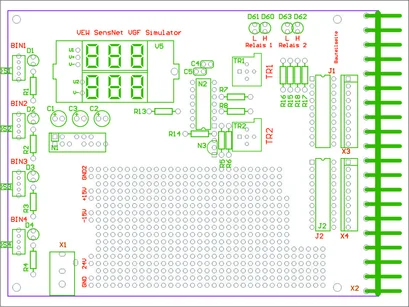VGF SensNet IoT
Produktbeschreibung (Kopie 1)
The Internet of Things (IoT) offers a cost-effective way to set up a reliable ,bidirectional, wireless sensor network for subordinate monitoring tasks, with command output via bistable, potential-free relay contacts.
The system presented here is housed in a 3HE 75x55x110mm clip-on housing for control cabinet DIN rail mounting.
The system is equipped with 20 terminals for the field signals.
There are 4 galvanically isolated binary inputs (A; B; C; D)
2 galvanically isolated, bistable relay outputs
with 1 pole changeover contact,
and 2 galvanically isolated analog inputs 0...10V or 0..20mA to disposal.
Other input-output channel configurations can be optionally manufactured.
The system is based on an Arduino MKR that can be programmed for specific applications. The Arduino is also available for WiFi and GSM.
For the development phase, a laboratory setup is available as a "breadboard" and an input/output simulator, with which the field signals can be simulated without the need for a complex laboratory setup.
The overall NB-IoT system with simulator is powered by a plug-in power supply unit and is immediately ready for laboratory tests.
The simulator is connected to the NB-IoT breadboard via a plug-in connection and provides two analog voltages that can be set independently of one another in the range of 0...10V with two digital displays, as well as 4 binary outputs that set the binary inputs of the NB-IoT breadboard via slide switches,as well as an LED monitor that shows the switch position of the two bistable relay outputs of the breadboard.
In addition, the simulator offers the possibility of building individual circuits on a perforated grid, as well as separating
all input/output channels between the simulator and the breadboard via DIP switches and feeding in external signals.
Once laboratory development is complete, the breadboard can be mounted on an adapter that carries DIN rail clips.
In this way, the field test can be carried out with the programmed breadboard directly in the control cabinet, since the breadboard has 20 terminals 1.5 square mm on the front side, to which the field signals are placed.
We reserve the right to make technical changes that serve the purpose of further development.
System development in cooperation with VGF (Stadtwerke Verkehrsges., Frankfurt/Main)
Technische Daten (Kopie 1)
| Supply | 24V DC, 24mA |
| Binary input | 4x galv. isolated, optocoupler 24V; A; B; C; D |
| Relay output | 2, 1pol. UM, bistable, max. 24V 1A |
| Analog input | 2, 0...10V or 0...20mA, galv. isolated |






